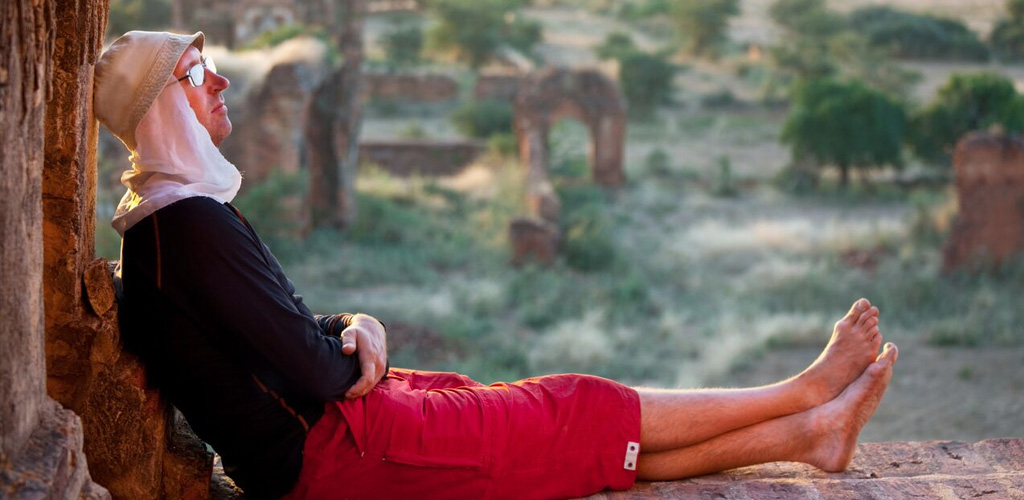Myanmar Arts Tours
Myanmar’s art world creates an enthralling paradox: ancient and yet embracing the sweeping change; unknown while highly revered in boutique circles; challenging cultural and political expression, yet clearly illustrating the long-standing damage that those limitations have caused. Such a paradox is inevitably laced with contradiction and there is no way to easily understand Myanmar’s art world without recognizing these contrasts.
Learn to recognize various new styles in Myanmar on our arts-focused trips. Through these our aim was to help visitors understand this blossoming nation from a more in-depth perspective always present and emerging in art communities. Myanmar art tours include a visit to galleries in Yangon and an inspection of Bagan’s old temples murals. But more than simply viewing, they aim to provide an immersive experience, one that journeys to the heart of the paradox. Because it is through the enigma of art that you can explore a much broader part of local culture and society.
IN depth Myanmar Art Tours
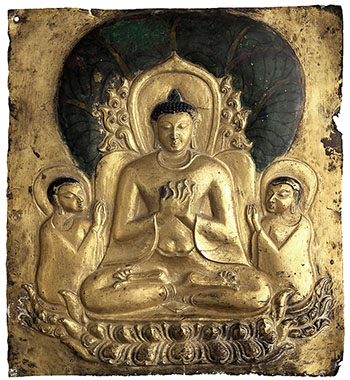
Our trips in Myanmar meet with premier artists, who embody personas as wide as the works they create. Young artists running their own galleries and slowly finding international recognition; those tackling Traditional Buddhist art from Bagan, Myanmarsubjects once forbidden by politics; pioneers of technique who developed styles during Myanmar’s imposed isolation from foreign influence. It’s these artists who provide narration on what went before, both the challenges and the successes, and the direction of travel the country’s art work may take in the future.
Expert guides in Bagan offer a context to the old religious art, particularly how it communicates Buddhist narratives in styles that have changed through the centuries. Ten traditional art forms are widely celebrated in Myanmar and each of these can create an interactive experience in different parts of the country, like stucco relief, woodcarving, lacquerware, sculpture. Multi-day Myanmar art tours can take you on the complete journey, through the old and the new, the mesmerizing touch of past masters to the architects of tomorrow. As all our tours are customized, any visit to Myanmar can include any of these artistic experiences, a fresh experience to compliment other adventures in the country.
Burmese Artists Take Flight
Art has always been an integral part of the culture of Myanmar, so historically important that ten traditional art forms have been called pan sè myo or "The Ten Flowers." These ten forms, include sculpture, blacksmithing, lacquerware, painting, woodcarving, stucco relief, masonry, turnery, and bronze casting, and have survived war, insurrection, revolution, and the long passage of time, changing and persevering, but never leaving the Myanmar people without means of expression.
These historical art forms can still be seen everywhere in Myanmar—in Bagan, early Burmese paintings dating from the 11th to 13th centuries can still be seen, decorating the walls of temples and monasteries and in many sites throughout the country, the buildings themselves, whether temples, palaces, monasteries, or stupas, still show the ingenuity and imagination of early Burmese sculptors and masons.
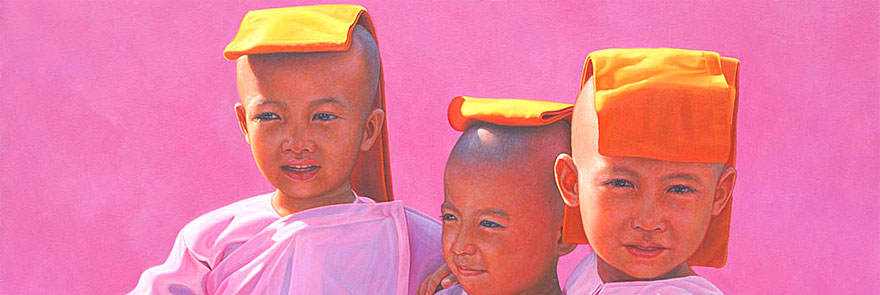
Traditionally, artists in Myanmar worked primarily on religious art, communicating Buddhist narratives visually in paintings, stone, bronze and wood sculptures, textiles, and lacquer as their counterparts in Europe were doing under Christianity. Similarly, secular art was far less common than religious art and from about the 5th through the early 20th centuries, Burmese artworks were mainly objects created for temples, monasteries, with sculptures and objects commissioned by donors, and for personal devotion.
The Bamar capital was then established on the Irrawaddy River at Pagan (Bagan). In Pagan, a depth of Buddhist instigated the construction of over two thousand brick temples, stupas, and monasteries over several centuries. Although the religious art created in Pagan was influenced by India, its artisans and architects created a distinctive aesthetic, which in later the later period of the empire diverged completely from Indian modes.
Artistic expression in Myanmar has often been throttled back by these religious and various cultural influences that haven’t plagued Western artists in the same way. While the Buddhist religion promotes peace and unity, the rules of modesty imposed by the religion have, in some cases, prevented artistic growth. For example, painting nude forms is a problematic theme with the expression of human nudity frowned upon. Buddhist traditions of the Burmese people mean they are also more culturally inclined to preserve norms and not to invite controversy. These two prominent themes in Burmese culture have meant that certain topics, like nude human forms, will always be subverted. Instead, painters in the region have learned to primarily execute designs that are non-controversial, like landscapes, portraits of monks, religious themes, and market day scenes.
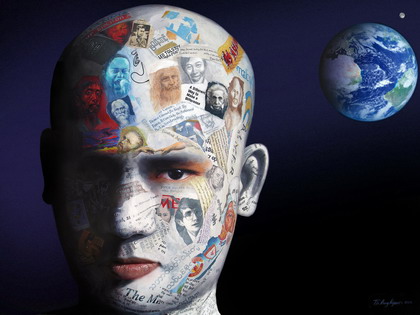
The country's tumultuous and infamous recent political history has served to complicate matters further. The military rule of Myanmar has, from time to time, forced isolation on the nation, sharply restricting the amount of foreign artistic influence, and its corresponding growth, that could enter the native art community. One will discover the scope of the artwork in the country has been able to grow in terms of technique and execution, although there has not been much in the way of pushing the envelope so common by artists in the West.
However, like the other sweeping changes affecting the country, all of this may be headed toward change. The country is more open to foreign visitors now than in recent history, the Internet has begun to trickle through Myanmar, Myanmar’s government censorship board was abolished in 2012 and hesitant artists are tackling once-forbidden subjects like politics with a resurgence in the local gallery scene, largely focused in Yangon. Many artists here are now working hard to challenge the limits of the art scene in Myanmar, and to find a world stage for their work.
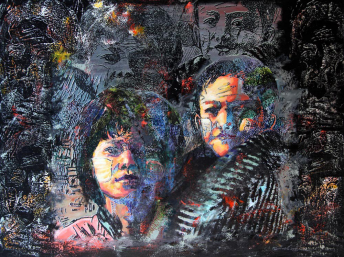
Surprising to some art-focused travelers, Burmese artists do not all fit into the “starving artist” stereotype and will find a variety of personas, from the 74-year-old retired math teacher Kyee Myintt Saw to the 39-year-old Nyein Chan Su, artists who are running their own galleries, and taking steps to make enough sales to continue art as a career, hoping to be discovered by the outside world. And that recognition is coming.
One of the harbingers of change is the River Gallery. Open for eight years now, the gallery is in the heart of Yangon, situated in an annex of the stately Strand Hotel. Owned and operated by a New Zealand expatriate, the gallery provides a showcase for new and established artists, and its location makes it easy to get high profile exposure. Artists exhibited here include Zaw Win Pe and Mor Mor. Ms. Mor’s painting Next won the 2008 Audience Choice Award at Hong Kong’s 2008 pan-Asian Sovereign Art Prize.
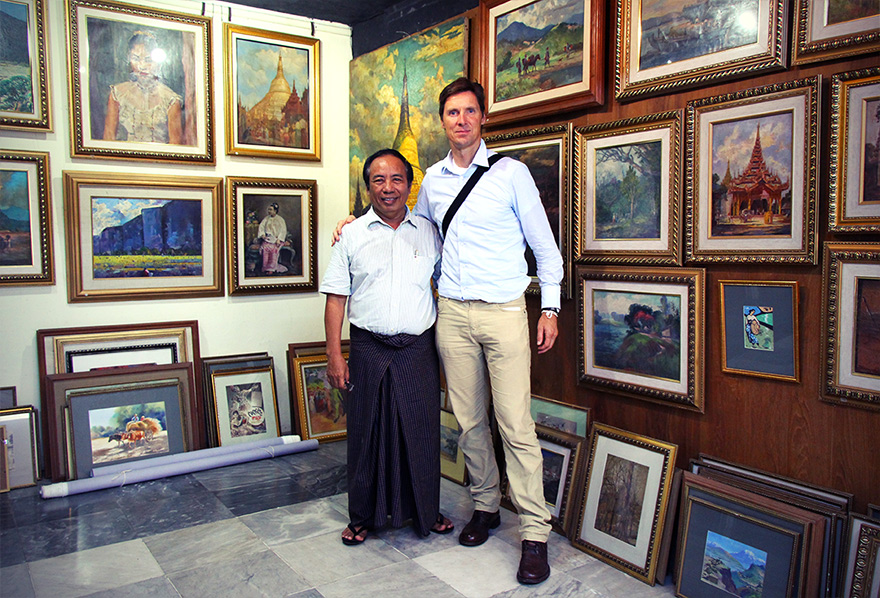
Other galleries in town are not so easy to find, especially the home-based ones, but we can make introductions during your visit in Yangon. For example, the work of Aung Myint is featured in his own Inya Gallery, housed in a two-room garage. Though the space is not prepossessing, the artist is internationally recognized. In 2002 he became the first Burmese artist to win at the Asean Art Awards. The nonprofit gallery and art school New Zero Art Space occupies two floors of an office building, but their limited real estate hasn’t stopped them from dreaming big. Their new artist in residence program invites international artists to visit the location short term and to exchange ideas with local artists. This type of grassroots involvement is working to undo the damage caused by years of cultural and political limitations on artistic expression.
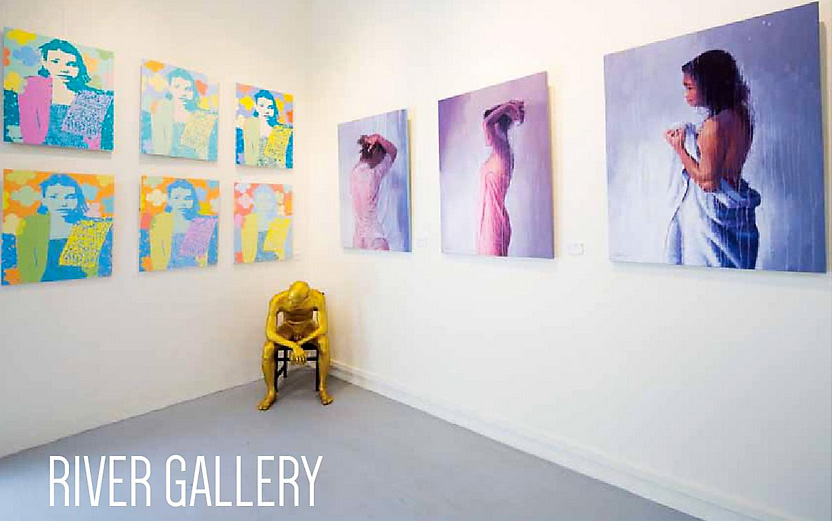
In particular, Pattison says "For their high levels of creativity, I love to see the works of Htein Lin, Aung Ko, Nge Lay and Arkar Kyaw ." As far as the future, Pattison compares India's recent art scene with what's happening in Myanmar: "In many Asian countries, including India, it was the development of a sizable middle class with higher levels of disposable income whuch drove the development of the market for modernist and contemporary art. Myanmar is not yet at that stage, but I believe we'll see a similar evolution here as the country develops, some of the Myanmar diaspora returns and local people improve their livelihoods."
Pattison continues about what makes Myanmar art so interesting and different: "Andrew Ranard, an art critic who has written a book about Myanmar art (below), describes the scene here as a "Galapagos Island" of art, with forms that have evolved in isolation, containing echoes of a common past, but appearing now in a quite different manifestation. "
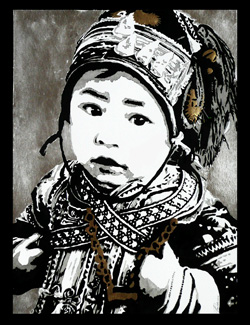
All of these artists may be working to build the art scene in Myanmar, but they also share a dedication to preserving their culture. Their culture and history live on in their artwork, and the influence of the past masters of the craft are visible in today’s works, some quite successfully. Min Wae Aung, an internationally acclaimed artist, whose renditions of Buddhist monks sell for up to twenty thousand dollars in Hong Kong, London, and Paris. With the absence of a national art museum in Myanmar, it has fallen to people like Mr. Aung to preserve the historic paintings of the nation. He has a collection that he calls the “Old Burmese Masters”, and is finishing construction on a new gallery in Yangon to house them adjacent his existing studio, New Treasure Art Gallery.
It is poignant as well to see the revival of modern and impressionistic art in Myanmar. After decades of repression from cultural and political forces, and the economic hardships that have accompanied many of the recent changes, what will end up on the canvas? Powerful influences like these, seldom faced by Western artists, leave a heavy mark on the artists living in Myanmar and it remains to be seen if the expression of these influences will ever be made clear to a global audience, or if it will be veiled in clues and hints and metaphor. In any case, the results are likely to be compelling as the country and artists open up the world.
In an unusual example the country's new era of reconciliation and openess (and perhaps more likely, Buddhist indifference), Khin Nyunt, the country’s former military intelligence chief and Prime Minister (formerly known as the Prince of Darkness), has opened a gallery in the courtyard of home (below). Non-traditional galleries and artist studios around the city can also be visited by preference, while in Mandalay, Inle Lake, and other remote areas of the country we will focus on traditional crafts, such as textile weaving.
Further Reading on Myanmar/Burmese Art
Burmese Painting: A Linear And Lateral History by Andrew Ranard

This is the first comprehensive history of Burmese painting, from eleventh-century Pagan to the present, including over 175 painters and more than 300 photographs of work. The book explores the historical transformations of the art, with psychological interpretations of major artists, the legends which followed them, and analysis of their oeuvres. It also probes the unusual lateral dimensions of Burmese painting, where 1,000 years of tradition have continued to survive and shape a rich corpus of largely unknown work.
Ranard links the traditional roots of Burmese painting in India with later influences from China, Thailand, Britain, Northern Europe, and America. Burma is an isolated country, but its art has been a major wellspring of inspiration in Southeast Asia. Today, the country struggles to reconcile complex pressures, and Ranard digs deeply to uncover layers of conflict reflected in Burmese painting. (Amazon)
Articles on Myanmar Art & Artists
Buddhist Art of Myanmar review: A Subtle, Sculptural Nirvana, The Guardian, by Jason Farago, Feb. 2015
New Vistas for Burmese Artists New York Times OCT. 21, 2011, By CEIL MILLER BOUCHET
Myanmar's Contemporary Art Scene is Emerging from Tight Censorship, English RFI
New Freedom for Myanmar’s Artists New York Times DEC. 2, 2014, By PHILIP HEIJMANS
Burma’s Feared Ex-Spy Chief Finds a New Life as a Gallery Owner, by Hannah Beach, May 30, 2013
Myanmar's Young Artists and Activists by Joshua Hammer, Smithsonian, March 2011
Burma and Burmese Arts on Pinterest
Traditional Art Venues and Galleries in Myanmar
Museums are few in general in Myanmar, though the government s making plans to reopen or establish new ones in the coming decade. Here are a handful of notable ones featuring traditional, primarily religious art.
The National Museum of Myanmar
The country's principal cultural museum on Pyay Road, near Shwedagon Pagoda and The Governor's Residence, Open 9-4:00 PM, Closed Fridays.
Bagan Archaeological Museum
Located in Old Bagan, a short walk from Ananda Temple and near the river. Hundreds of objects, murals and relics displayed in hodge podge fashion. Open 9:30 to 4:00 PM except Mondays.
Hmawza (Sri Ksetra Archaeological Museum) in Pyay
If visiting the ruins of the old city of Sri Kshetra near Pyay (formerly known as Prome), you should begin with a visit to this small museum.
Kaba Aye Buddhist Museum (Yangon)
Located at the pagoda of the same name, features a wide collection of religious paraphernalia and Buddhist texts. Kabar Aye Road in Mayangone Township, north of Inya Lake (a good place to stop en route from or to the airport) open daily from 6:00 AM to 8:00 PM.
Art Galleries in Yangon
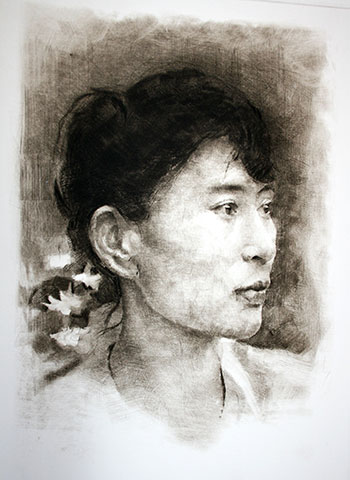
Anawmar Art Gallery
18A Thukhawaddy Road, Sooniram Park, Yankin Township
Beik Thano Gallery
113/3B, Kaba Aye Pagoda Road, Bahan, (95-1) 542 560
https://www.facebook.com/beikthanogallery
Gallery 65
65 Yaw Min Gyi Road, Dagon Township, (95-1) 246317
Inya Art Gallery
50B Inya Road, Kamayut Township, (95-1) 524818 or (95-1) 524327
KZL Studio and Gallery
184/84(A), Golden Hill Road, Shwe Taung Gone, Bahan Township, (95-9) 5333518
Lokanat Art Gallery
62, 1st Floor, Pansodan Street, Kyauktada Township, (95-1) 382269
Nawaday Art Gallery
27 Nawaday Street, Mayagone Township , +95 (0) 943199898
Nawaday Tharlar Art Gallery
Room 304, 3rd Floor, 20B Yaw Min Gyi Road, Rangoon, Burma, +95 (0)9 43097918
New Treasure Art Gallery
84A Thanlwin Road, Golden Hill Avenue, Golden Valley, Bahan Township, (95-1) 526776, (95-1) 503712
New Zero Art Space
202 United Condo, Alanpya Phayar Road, Dagon Township, Rangoon, Burma, (95-9) 73129520
Pansodan Art Gallery
1st Floor, 286 Pansodan Street (Upper Block), Kyauktada Township, (95-9) 5130846
River Gallery
Strand Hotel Annex, 92 Strand Road, (95-1) 243377/8/9 (Ext) 1810
Web: www.rivergallerymyanmar.com/
TS1 GALLERY & SHOPPING COMPLEX
Transit Shed No. 1, Between Lanthit Jetty and Kaing Dan No. 1 Jetty
Web: http://ts1yangon.com/
